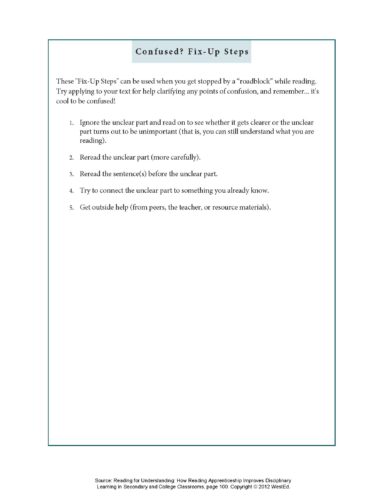As students identify and describe their reading processes and problems, they will naturally include their problem-solving processes. For many students, the Fix-Up Steps Protocol is useful when they get stopped by a “roadblock” and need to clarify a point of confusion in a text. The last step, getting outside help, should become increasingly comfortable for students when the collaborative structure of the classroom begins to reveal their peers as valuable outside resources.
Research About Education and Economic Power
Even a simple investigation of research showing relationships between literacy and financial life trajectories can build motivation and create a shared context for the effort the class will undertake as they engage with challenging texts. Students might be interested in the following research linking education and earnings.
The Reading Apprenticeship Framework Graphic
The Reading Apprenticeship approach is based on a unique framework of four interacting dimensions of learning that support both academic and social-emotional learning: Social, Personal, Cognitive, and Knowledge-Building.
These four dimensions are integrated into subject-area teaching and developed through Metacognitive Conversation that explores students’ thinking processes. Students think and talk about how they learn as well as what they learn. This collaborative work takes place within the context of Extensive Reading — increased in-class opportunities for students to practice reading in more skillful ways.
This PDF consists of two pages, with two versions of the framework: one that is filled in, and one that is blank for student use.
Reading for Understanding – Chapter Two Excerpt
Chapter 2 of Reading for Understanding, “The Reading Apprenticeship Framework,” describes how the basis of the Reading Apprenticeship approach to teaching reading in subject-area classes is grounded in our view of learning as a social-cognitive interactive process. Download and read this chapter or view a summary of the framework here for more information.
Essay Rubric – Biology
The Integrated Learning Assessment (ILA) measures secondary student engagement and use of metacognitive and comprehension-supporting routines that help students to become self-monitoring and self-governing readers of history or science texts. The ILA also measures student achievement in these subject areas and in literacy.
As a performance-based assessment, the ILA integrates CRESST’s work on model-based assessment and explanation tasks with Reading Apprenticeship’s curriculum-embedded reading assessment, the CERA. Students read a set of complex, grade-level history or science texts, describe their reading and thinking processes, answer a set of comprehension questions, and do some writing on a topic that integrates information from these texts into a coherent essay. Scoring is based on a rubric and attends to students’ comprehension and conceptual understanding, and to students’ literacy and historical or scientific thinking and discourse processes.
ILA research tools include subject-related assessments and scoring guidance.
A version of this rubric is available for history.
Essay Rubric – History
The Integrated Learning Assessment (ILA) measures secondary student engagement and use of metacognitive and comprehension-supporting routines that help students to become self-monitoring and self-governing readers of history or science texts. The ILA also measures student achievement in these subject areas and in literacy.
As a performance-based assessment, the ILA integrates CRESST’s work on model-based assessment and explanation tasks with Reading Apprenticeship’s curriculum-embedded reading assessment, the CERA. Students read a set of complex, grade-level history or science texts, describe their reading and thinking processes, answer a set of comprehension questions, and do some writing on a topic that integrates information from these texts into a coherent essay. Scoring is based on a rubric and attends to students’ comprehension and conceptual understanding, and to students’ literacy and historical or scientific thinking and discourse processes.
ILA research tools include subject-related assessments and scoring guidance.
A version of this rubric is available for biology.

